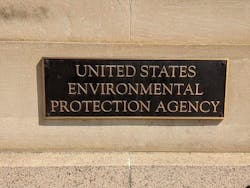The United States Environmental Protection Agency (EPA) announced drinking water health advisories for four per- and polyflouroalkyl substances (PFAS) on June 15, 2022.
In October 2021, EPA released its PFAS Strategic Roadmap to address 29 PFAS and lithium in water and announced its intention to regulate these contaminants to protect public health.
Though health advisories are not enforceable regulations, they are intended to share the latest information that EPA knows about contaminants and the risks they pose to the public.
The four chemicals listed for health advisories in the press release and their health advisory limits are:
- Perflourooctanoic Acid (PFOA): 0.004 ppt (or 4 parts per quadrillion)
- Perflourooctane sulfonic acid (PFOS): 0.02 ppt
- Perfluorobutane sulfonic acid and its related compound potassium perfluorobutane sulfonate (PFBS): 10 ppt
- Hexaflouropropylene oxide, dimer acid and its ammonium salt (more commonly known as GenX or HFPO): 2,000 ppt
These levels are based on new science and consider lifetime exposure. Additionally, the levels noted above “are near zero and below EPA’s ability to detect at this time.”
RELATED: Just How Much is a Part Per Trillion? | WaterWorld, May 2022.
Below are comments from industry associations and government leaders on this announcement. To summarize the common themes, associations raise concern regarding the parts per quadrillion measurement, but note the importance of creating national standards for the family of chemicals often referred to as “forever chemicals.”
For comments from U.S. EPA Administrator Michael Regan and U.S. EPA Assistant Administrator for Water Radhika Fox, read the agency’s full press release.
American Water Works Association Statement
The American Water Works Association issued a statement on the day of the announcement, which also coincided with the final day of its annual conference and exhibition, ACE22. In its statement, AWWA said the advisory levels provide a guide, but that those figures are not without their concerns.
“Health advisories provide states and water utilities with a reference point as they evaluate potential contamination and appropriate responses to assure the safety of drinking water,” the statement said. “The PFOA and PFOS advisory levels are extremely low and do not reflect the draft recommendations of EPA’s own expert Science Advisory Board review. The health advisory levels are parts per quadrillion, undetectable by modern laboratory methods.”
AWWA recognizes the need to safeguard the public from PFAS contamination and it supports national standards for regulating PFAS contaminants. EPA is currently working to set a maximum contaminant level (MCL) for these chemicals under the Safe Drinking Water Act (SDWA) with a proposal expected in the fall of 2022.
“Through the SDWA regulatory process, many utilities are sampling for PFOA, PFOS and other PFAS to better understand where they occur and at what levels,” the statement went on. “They are sharing that information with their communities. It’s important that EPA complete this rule-making process so that states, utilities, and consumers have a clear and consistent path forward for managing harmful levels of PFAS in drinking water.”
Water Environment Federation Statement
A Water Environment Federation (WEF) statement reiterated that these new health advisories are “not enforceable regulations.” WEF President Jamie Eichenberger said reducing the health advisory level so considerably from the previous (2016) level is a big deal.
“EPA’s decision to reduce these health advisory levels from 70 ppt to as low as 0.004 ppt will have a significant impact on water utilities, who receive these chemicals from industry and consumers and are not generators themselves,” Eichenberger said in the press release. “We encourage EPA to continue to work toward source control to prevent these contaminants from entering our waterways in the first place and are looking forward to working with EPA to develop science-based effluent limits and drinking water standards that protect public health and the environment without placing an undue burden on our utilities and ratepayers.”
National Ground Water Association
The National Ground Water Association (NGWA) applauded the move forward on regulating PFAS chemicals in a statement from NGWA CEO Terry S. Morse, CAE, CIC.
“For organizations like NGWA that have spent years advocating for national regulations on PFAS and PFOA chemicals, today’s announcement from the EPA is certainly welcome news,” Morse said. “Now it’s more important than ever that we let the science and data guide these actions because the more we learn about PFAS and PFOA, the more we seem to uncover about how serious and complex the problem really is.”
NGWA noted in its statement that the use of lifetime health advisories “also take into account other potential sources of exposure to these PFAS beyond drinking water (food, air, consumer products, etc.), which provides an additional layer of protection.”
Additionally, NGWA directed those concerned about PFAS in their drinking water to consider actions to limit or reduce their exposure, “including installing a home or point of use filter.”
Quotes from Congressional Leaders
Congressional leaders also shared public comments and statements. Below are a select few quotes from press releases from U.S. Senator and ranking member of the Senate Committee on Environment & Public Works Shelley Moore Capito (R-WV) and U.S. Rep. Chris Pappas, who introduced the Clean Water Standards for PFAS 2.0 Act alongside U.S. Senator Kirsten Gillibrand (D-NY) in May.
Shelly Moore Capito (R-WV)
“As one of the leaders in the Senate on PFAS, I am extremely disappointed EPA has decided to act so radically and rashly on such a bipartisan issue,” Capito said. “Let’s be clear: No technologies exist for water systems to detect PFOA and PFOS contamination at the infinitesimal levels EPA has set in its proposed lifetime health advisory levels. EPA’s announcement will only increase confusion for water systems’ compliance efforts and further complicate risk communication to the public. Setting these impossible levels misleads the public into thinking their water isn’t safe, even when that may not be true.”
Congressman Chris Pappas (NH-01)
“Today’s announcement of new drinking water health advisories is welcome news for communities that need to be able to accurately determine whether or not their water is safe,” Pappas said. “But the EPA continues to fall short of the action our families need by failing to take meaningful action to keep these toxic ‘forever chemicals’ out of our water in the first place. No industry should be given a free pass to poison our water, and no family should ever have to wonder whether their drinking water is safe when they turn on the tap. My Clean Water Standards for PFAS Act would finally take action to hold polluters accountable, establish proactive limits for PFAS discharges, set water quality criteria, and support communities with contaminated water. It is essential that EPA finally set these limits, and I’ll keep fighting to pass this legislation until they do so.”




